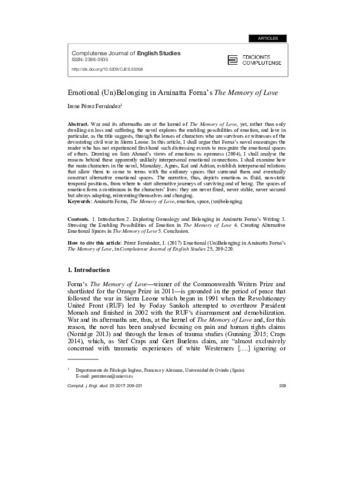Emotional (Un)Belonging in Aminatta Forna’s The Memory of Love
Autor(es) y otros:
Palabra(s) clave:
Aminatta Forna
The Memory of Love
Emotion
Space
(un)belonging
Fecha de publicación:
Editorial:
Universidad Complutense de Madrid
Versión del editor:
Citación:
Descripción física:
Resumen:
War and its aftermaths are at the kernel of The Memory of Love, yet, rather than only dwelling on loss and suffering, the novel explores the enabling possibilities of emotion, and love in particular, as the title suggests, through the lenses of characters who are survivors or witnesses of the devastating civil war in Sierra Leone. In this article, I shall argue that Forna’s novel encourages the reader who has not experienced first-hand such distressing events to recognize the emotional spaces of others. Drawing on Sara Ahmed’s views of emotions as openness (2004), I shall analyse the reasons behind these apparently unlikely interpersonal emotional connections. I shall examine how the main characters in the novel, Mamakay, Agnes, Kai and Adrian, establish interpersonal relations that allow them to come to terms with the ordinary spaces that surround them and eventually construct alternative emotional spaces. The narrative, thus, depicts emotions as fluid, non-static temporal positions, from where to start alternative journeys of surviving and of being. The spaces of emotion form a continuum in the characters’ lives: they are never fixed, never stable, never secured but always adapting, reinventing themselves and changing
War and its aftermaths are at the kernel of The Memory of Love, yet, rather than only dwelling on loss and suffering, the novel explores the enabling possibilities of emotion, and love in particular, as the title suggests, through the lenses of characters who are survivors or witnesses of the devastating civil war in Sierra Leone. In this article, I shall argue that Forna’s novel encourages the reader who has not experienced first-hand such distressing events to recognize the emotional spaces of others. Drawing on Sara Ahmed’s views of emotions as openness (2004), I shall analyse the reasons behind these apparently unlikely interpersonal emotional connections. I shall examine how the main characters in the novel, Mamakay, Agnes, Kai and Adrian, establish interpersonal relations that allow them to come to terms with the ordinary spaces that surround them and eventually construct alternative emotional spaces. The narrative, thus, depicts emotions as fluid, non-static temporal positions, from where to start alternative journeys of surviving and of being. The spaces of emotion form a continuum in the characters’ lives: they are never fixed, never stable, never secured but always adapting, reinventing themselves and changing
DOI:
Colecciones
- Artículos [37546]
- Filología Inglesa, Francesa y Alemana [591]
Ficheros en el ítem





